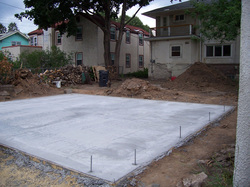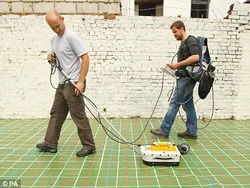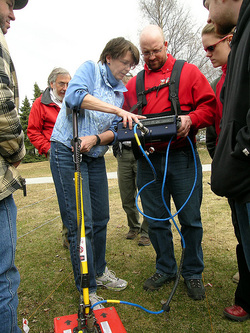 Ground penetrating radar is a valuable tool for identifying concrete slab thickness very easily along with accurately. Determining slab thickness is essential in seeing exactly how concrete pavements may perform during their service life. Note that even a reduction in the thickness of the slab simply by less than one inch can easily cut in half its service life. Calculating the thickness of concrete slabs is additionally important in figuring out if contractors have complied with the job specifications when developing concrete pavements. GPR is technology that's already being widely used in numerous states within their pavement evaluation systems, including North Carolina, Texas, Florida, Michigan along with Louisiana, as well as in quite a few European nations such as the UK, Finland and Denmark, with much success. The radar sends short pulses of radio waves into the concrete and then utilises the arrival time along with strength of the returning echoes to calculate thickness as well as properties including moisture content. However, GPR may not be in a position to make accurate measurements if there's not enough contrast between the concrete along with the underlying base. What are the advantages of using GPR in computing concrete slab thickness? - Thickness data coming from the GPR can be instantly imported directly into pavement management systems so that they can determine the remaining life of the concrete pavement and determine the right maintenance along with repair actions. Radar readings may end up being changed into visual representation for simple interpretation or as ASCI file output.
- Measurements may end up being carried out by GPR equipped cars with minimal disruption to regular traffic since there's no more any need to close down lanes while measurements are generally being taken. Cars may cover around two hundred miles per day of pavement at typical highway speeds. And automated data collecting substantially cuts down on the time required to complete the survey.
- The cost of GPR is more affordable in comparison with conventional methods of identifying slab thickness including taking core samples. Concerned agencies have the option of buying their own equipment and training personnel to man it or even contracting services from providers, depending on the spending budget available to them for these functions.
- Highway personnel usually are completely safe whenever taking measurements since they are no longer subjected to hazardous situations for example high-speed traffic, inclement weather as well as air pollution.
- GPR enjoys a high range of accuracy within its measurements of concrete slab thickness. With respect to the type of layer being measured, you can enjoy accuracy within range of 3 % to 5 % (for new asphalt). But even measuring thick granular base can provide results precise to inside range of 8 % to fifteen percent.
 Ground penetrating radar services tend to be versatile enough to be useful for a number of applications, which range from finding hidden utility pipes as well as conduits within concrete slabs to locating historical treasures around excavation sites. This particular technology fundamentally draws a picture of what's buried underground by sending pulses of radio waves into the target area. Whenever the waves come across an obstruction, they create echoes which may be graphically shown on the GPR unit's screen. There usually are 3 basic types of data which can be supplied by a ground penetrating radar device. The standard is 2D data, which is actually the raw data that is created by the GPR and shows up as a number of roughly-drawn lines upon the screen. 3D data is made by merging multiple 2D readings to produce 3D picture. Lastly, point data is actually created whenever the GPR is coupled with a global positioning system unit. The coordinates produced by the GPS tend to be blended with the GPR data to produce as-built drawings on CAD or even GIS software. Ground penetrating radar services generally take about three approaches to a GPR survey. The first is to basically examine the site for indications to the desired targets, and then make use of this as a starting place for a much more detailed search. The GPR is actually moved across the suspect area right up until the target is found, and then marked on the ground or its coordinates logged using a GPS. Using mark out approach, a more systematic search is undertaken simply by dividing the search area straight into a grid and then moving the GPR across each individual square in orderly search pattern. Lastly, there is actually the generation of a 3D map of the search area, which can be produced using the information generated from earlier searches using the first couple of approaches. Whenever using the services of ground penetrating radar services there tend to be three main considerations to bear in mind: 1. What sort of technology are they using? You may wish to use service which uses the most current GPR devices accessible to make sure you get the outcomes you need. 2. Do they have a highly trained staff? Even though it is easy to operate the GPR unit itself, you still want to have a skilled technician available to interpret the readings to ensure that absolutely nothing is missed. 3. Exactly how long have they been operating? You may wish to seek the services of a service that's well-established in your town to ensure that they are reliable and will supply you with the services that you might want.
 Ground penetrating radar recently promised to become important in the solving of one of America's most enduring unsolved mysteries: the final fate of former Teamster's Boss Jimmy Hoffa. After a tipster informed Roseville, Michigan cops that he spotted a body being buried underneath the driveway in July 1975, just a day after Hoffa vanished, the authorities utilised GPR and then detected an "anomaly" beneath the site. However, dirt samples taken for analysis proved that no human remains had been buried there, and the solution to Hoffa's disappearance remains to be discovered. For some customers, however, GPR is often made use of for more mundane reasons. For instance, GPR technology can certainly determine whether there are underground water mains or maybe utility lines in construction sites which might be broken during excavation and which could result in work downtime and expensive delays because of repairs to the damage caused. In addition, it can pick up on the existence of obstructions like reinforcing metal and voids, which could result in worker injury. Additionally the price of utilising the technology is ultimately more cost-effective when compared to the cost of having to cover the expense associated with accidents and structural damage. Ground penetrating radar makes use of high frequency radio signals sent into the ground for you to find underground objects. Their existence is indicated when the signal comes back to the receiver as echoes and so the findings are shown on the GPR display screen. The depth and position of the things are depicted simply by the amount of time it takes the echo to travel to and from it. The data are at that point translated by the operator whether the item is the root or subsurface infrastructure. Software can also be utilised to turn the raw data into 3-D maps that permit the features to become more easily translated since they are presented in a more visual mode. Different types of ground penetrating radar models can be used based on the item being found and the surface type on which it is being utilised. Like for example, for anyone who is finding rebar in cement, the 1,000 MHz high-frequency GPR can be used as that will give high resolution for as much as Twenty-four inches deep. Alternatively, in case you require deeper penetration, just like when the radar is being used in ground soil, reduced frequencies from 12.5 MHz up to Five-hundred MHz are usually utilised which can provide depth range that could go from several inches up to thousands of feet.
 Concrete X-ray is actually a inaccurate name because so many builders make use of it to mean ground penetrating radar. Leading to the confusion is the fact that, even though cement radiography is increasingly being replaced with GPR, the older technology is currently available. Concrete radiography comprises of making x-ray images of the layers of concrete to determine where post-tension cables, rebar and also conduits are situated in it. The X-ray unit can go through as much as thirty inches within the slab and frequently even deeper based upon composition, then make really thorough pictures that are simpler to interpret when compared with GPR facts. Are there any other distinctions between concrete x-ray and GPR? 1. Cement radiography must be prepared off-site. The results of the scan are put onto x-ray film, that still has to get developed before the results can be viewed. Using GPR, the outcomes immediately show up on the unit's digital monitor. However, most radiography providers have mobile darkrooms that enable the film to be|developed on site, so you have the results quickly. 2. Cement radiography uses both sides of the slab for scanning, with one side having the film and the other the reflector plate. Therefore, there are limitations with the thickness of the slab to be scanned. If you have iridium-based radiography devices, you could scan a slab up to twelve inches, whilst with cobalt-based radiography you are able to scan slab with a maximum thickness of thirty-six inches. 3. Concrete radiography needs the operator to put on safety gear such as a lead apron to make sure they're protected, also having an eighty foot clearance surrounding the slab to ensure that onlookers won't be exposed to rays from the x-ray equipment. 4. Concrete radiography is higher priced than ground penetrating radar because of the higher cost of the device involved together with the salary of the x-ray professional working with it. Alternatively, the GPR technician could be trained to handle the machine just in 24 hours, though you would always require a seasoned technician to be able to interpret the information. 5. Concrete radiography can't collect data on large building sites. In order to collect facts on larger slabs, you will have to continuously set up the concrete x-ray unit at different places that you plan to take readings. By comparison, GPR is a tool which can take measurements of large areas just by being set up once.
 Concrete scanning is the most essential technologies for building contractors digging up a house construction site, because it helps them track down and get away from problem areas that can induce work slowdowns or maybe shutdowns. Also known as ground penetrating radar (GPR), this kind of solutions works on the radar that will gives off short jolts of radio wave pulses to see if there is any obstructions in the underground part. The presence of an obstruction is shown whenever an echo is read and also the depth where it is positioned can be determined by how long echo takes to send back along with the intensity on the signal.
Concrete scanning is often employed for the following applications:
- Diagnosing leaks in water pipes. It can be hard to look for leaking in lines running under concrete slabs and never have to investigate slab. By using GPR, you can easily know if there is drip and the place where it is so plumbing engineers will start digging in that section. Unknown and then unrepaired leakages can result in exorbitant water expenses in addition to major damage to property.
- Finding power pipes. One of the biggest risks within building construction sites is the fact that you´ll accidentally dig into underground power lines, resulting in damage that may cause lots of money to refurbish. GPR enables you to determine areas where there are power lines to enable them to be avoided.
- Distinguishing soil structure. GPR could review the structure of the ground where structure is to be built, to be sure structural reliability and get away from later complications, just like the base suddenly going down because of the soil is too soft to take its weight.
Even so, GPR innovation does have its boundaries, one of the most major of which is that it can not work also in some types of land surface, such as wet clay that soil that has been greatly afflicted by salt.
Prior to site undergoes concrete scanning, there are certain things you should do to organize it to allow you to get essentially the most accurate effects from GPR.
- Get rid of all clutter from the area to be read, because this can affect the radar and alter the final results.
- Determine substitute places to be examined in the event the initial section turns out to be not fit.
- Make certain that the ground is dried out just before having it scanned, as liquid reflects radar signals and therefore, radar would give undependable effects.
- If you are using the radar in order to identify underground conduits, switch on all the circuits as higher current conduits are simpler to discover as compared to low voltage ones.
Contact CSI Concrete Scanning and Investigations before you drill, cut or core concrete. For work place safety and to keep your project from costly down time, concrete scanning is essential.
|





 RSS Feed
RSS Feed